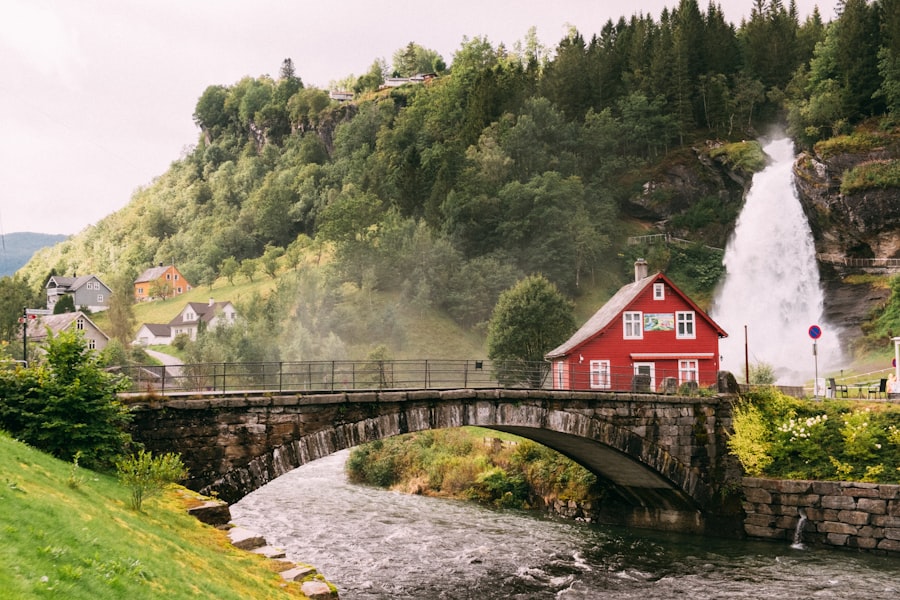Cycling is a popular mode of transport in Norway, with its picturesque landscapes and well-maintained cycling paths attracting both locals and tourists alike. However, as the sun sets and darkness envelops the roads, the importance of visibility becomes paramount. This is where bike lights and reflectors come into play.
These essential accessories not only enhance a cyclist’s visibility to others but also ensure their safety on the road. In a country where long winter nights are common, understanding the significance of bike lights and reflectors is crucial for every cyclist. Bike lights and reflectors serve a dual purpose: they illuminate the path ahead while simultaneously making the cyclist more visible to motorists and pedestrians.
The right combination of lights and reflectors can significantly reduce the risk of accidents during low-light conditions. As cycling continues to gain popularity in urban areas, it is imperative for cyclists to equip themselves with the necessary tools to navigate safely after dark. This article will delve into the legal requirements surrounding bike lights in Norway, the various types available, and how to choose and maintain them effectively. Book your 1-hour strategy session with Norway Relocation Group.
Summary
- Bike lights and reflectors are essential for safety when cycling, especially at night.
- In Norway, it is a legal requirement to have functioning bike lights and reflectors when cycling in low light conditions.
- There are various types of bike lights and reflectors available, including front lights, rear lights, and reflective accessories.
- When choosing bike lights and reflectors, consider factors such as brightness, battery life, and weather resistance.
- Proper installation, maintenance, and replacement of bike lights and reflectors are crucial for ensuring their effectiveness and compliance with legal requirements.
Legal Requirements for Bike Lights in Norway
In Norway, the law mandates that all bicycles must be equipped with specific lighting devices when riding after sunset or in poor visibility conditions. According to Norwegian traffic regulations, cyclists are required to have a white front light and a red rear light. These lights must be visible from a distance of at least 300 metres, ensuring that both cyclists and motorists can see each other well in advance.
Additionally, reflectors are also a legal requirement; bicycles must have reflectors on the front, rear, and on the pedals. Failure to comply with these regulations can result in fines and increased risk of accidents. The authorities take these laws seriously, as they are designed to protect cyclists on the road.
It is essential for cyclists to be aware of these legal requirements not only to avoid penalties but also to ensure their own safety and that of others. Understanding these regulations is the first step towards responsible cycling in Norway.
Types of Bike Lights and Reflectors

When it comes to bike lights, there are several types available on the market, each designed for different purposes. Front lights typically come in two varieties: those that provide a steady beam for illuminating the path ahead and those that offer a flashing mode for increased visibility. The brightness of these lights is measured in lumens, with higher lumens providing better illumination.
For night riding, a front light with at least 200 lumens is recommended. Rear lights are equally important, as they signal a cyclist’s presence to vehicles approaching from behind. These lights often come with various settings, including steady and flashing modes.
Some modern rear lights even feature built-in sensors that adjust brightness based on ambient light conditions. Reflectors, on the other hand, come in various shapes and sizes, including spoke reflectors, pedal reflectors, and those attached to the frame or seat post. Each type plays a vital role in enhancing visibility from different angles.
How to Choose the Right Bike Lights and Reflectors
Selecting the appropriate bike lights and reflectors can be overwhelming given the plethora of options available. When choosing front lights, consider factors such as brightness, battery life, and mounting options. A light that is easy to attach and detach is ideal for those who may need to remove it frequently.
Additionally, look for lights that offer multiple brightness settings; this versatility can be beneficial for different riding conditions. For rear lights, opt for models that provide a wide angle of visibility. This ensures that you are seen from various directions, not just directly behind.
Reflectors should be chosen based on their placement on the bike; ensure that they are positioned where they can catch light effectively. It is also wise to invest in high-quality products from reputable brands, as these are more likely to withstand the rigours of regular use and adverse weather conditions.
Proper Installation of Bike Lights and Reflectors
Once you have selected your bike lights and reflectors, proper installation is crucial for optimal performance. Front lights should be mounted at a height that allows them to illuminate the road ahead without blinding oncoming traffic. Typically, this means positioning them between 75 cm and 120 cm above ground level.
Ensure that the light is securely fastened to prevent it from wobbling or falling off during rides. For rear lights, they should be mounted at a height where they are easily visible to drivers behind you—usually around 100 cm above ground level is ideal. Reflectors should be attached firmly to their designated spots on the bike frame, wheels, or pedals.
Regularly check that all lights and reflectors are functioning correctly and are securely attached before embarking on any ride.
Maintaining and Replacing Bike Lights and Reflectors

Maintaining your bike lights and reflectors is essential for ensuring they function correctly when needed most. Regularly inspect your lights for any signs of wear or damage; this includes checking for cracks in the casing or issues with the lens that could affect brightness. Clean the lenses periodically to remove dirt or grime that may obstruct light output.
Battery maintenance is also crucial; if your bike lights use replaceable batteries, ensure you have spares on hand for longer rides. For rechargeable models, make it a habit to charge them after each use or at regular intervals to avoid being caught out with a dead light. Reflectors should be checked for any signs of fading or damage; if they appear dull or cracked, it’s time to replace them to maintain optimal visibility.
Consequences of Not Complying with Legal Requirements
Neglecting to comply with Norway’s legal requirements regarding bike lights can lead to serious consequences beyond just fines. The primary risk is personal safety; riding without adequate lighting significantly increases the likelihood of accidents during low-light conditions. Cyclists who fail to make themselves visible may find themselves involved in collisions with vehicles or pedestrians who cannot see them in time.
Moreover, non-compliance can lead to legal repercussions such as fines imposed by law enforcement officers during routine checks. These penalties can vary depending on the severity of the infraction but can add up quickly if multiple violations occur. Ultimately, adhering to these regulations not only protects cyclists from legal trouble but also fosters a safer environment for everyone on the road.
Additional Safety Tips for Cycling at Night in Norway
In addition to equipping your bike with proper lights and reflectors, there are several other safety tips cyclists should consider when riding at night in Norway. Firstly, always wear a helmet; this is crucial for protecting your head in case of an accident. Additionally, try to stick to well-lit routes whenever possible; this not only enhances visibility but also provides a sense of security.
It’s also advisable to ride at a moderate speed during night rides; this allows you more time to react to unexpected obstacles or hazards on the road. Use hand signals when turning or stopping to communicate your intentions clearly to other road users. Finally, consider riding with a buddy whenever possible; there’s safety in numbers, especially during nighttime cycling.
Reflective Clothing and Accessories for Cyclists
In conjunction with bike lights and reflectors, wearing reflective clothing can significantly enhance a cyclist’s visibility at night. Many cycling apparel brands offer jackets, vests, and trousers made from materials that reflect light effectively. These garments are designed not only for visibility but also for comfort during rides.
Accessories such as reflective armbands or ankle bands can further increase your visibility without compromising style or comfort. Additionally, consider using reflective tape on your helmet or bike frame; this simple addition can make a substantial difference in how visible you are to others on the road.
Resources for Purchasing Bike Lights and Reflectors in Norway
For those looking to purchase bike lights and reflectors in Norway, there are numerous resources available both online and in physical stores. Local bike shops often carry a wide range of products tailored specifically for Norwegian cycling conditions. Staff members can provide valuable advice on which products best suit your needs.
Online retailers also offer extensive selections of bike accessories, often at competitive prices. Websites dedicated to cycling gear frequently feature customer reviews that can help guide your purchasing decisions. Additionally, consider checking out local cycling clubs or community groups; they may have recommendations for trusted suppliers or even group discounts available.
Conclusion and Summary of Legal Requirements
In conclusion, understanding the importance of bike lights and reflectors is essential for every cyclist in Norway. The legal requirements stipulate that all bicycles must be equipped with a white front light and a red rear light visible from at least 300 metres away, along with reflectors on various parts of the bike. Compliance with these regulations not only helps avoid fines but also significantly enhances safety while cycling at night.
By choosing appropriate lighting options, ensuring proper installation, maintaining equipment regularly, and adhering to additional safety tips such as wearing reflective clothing, cyclists can enjoy their rides while minimising risks associated with low-light conditions. As cycling continues to thrive in Norway’s vibrant culture, prioritising safety through proper equipment will ensure that all cyclists can navigate their journeys confidently and securely.
Speak Norwegian with confidence. Enroll in a class at the NLS Norwegian Language School now.

